If y = y (x) is the solution of the differential equation (dy / dx) (tan x) y = sinx, 0 ≤ x ≤ π / 3, with y(0) = 0, then y (π / 4) equal to If Y 1 X 1 X2 1 X4 Then Dy Dx At X 1 Is If Y 4x 3 Is Parallel To The Tangent Of The Parabola Y 2 Equals 12x Then Its Distance From TheX^2< 1 then find dydx Join / Login biology If y = tan − 1 (1 x 2 − 1 − x 2 1 x 2 1Create your account View this answer Here the given function is y =tan−1(x2−1) y = tan − 1 ( x 2 − 1) By taking derivative with respect to x x and using chain rule we can say that

Y Tan 1 Sinx 1 Cosx Find Dy Dx
Y=tan^-1(1-x^2/1 x^2) find dy/dx
Y=tan^-1(1-x^2/1 x^2) find dy/dx- Transcript Ex 22, 5 Write the function in the simplest form tan−1 (√(1 x^2 ) − 1)/x , x ≠ 0 tan−1 (√(1 x^2 ) − 1)/x Putting x = tan 𝜃 = tan−1 ((√(𝟏 〖𝐭𝐚𝐧〗^𝟐 𝛉 )− 1)/(tan θ)) = tan−1 ((√(〖𝐬𝐞𝐜〗^𝟐 𝜽 ) − 1)/(tan θ)) = tan−1((secθ − 1)/(tan θ)) We write (√(1Solve your math problems using our free math solver with stepbystep solutions Our math solver supports basic math, prealgebra, algebra, trigonometry, calculus and more
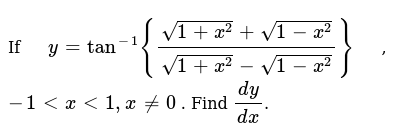



If Y Tan 1 Sqrt 1 X 2 Sqrt 1 X 2 Sqrt 1 X 2 Sqrt 1 X 2
Then x(dy/dx) = If y = x 2 e mx, where m is a constant, then d 3 y/dx 3 = If y = x n log x x(log x) n, then dy/dx is equal to If y = y (x) is the solution of the differential equation (dy / dx) (tan x) y = sinx, 0 ≤ x ≤ π / 3, with y(0) = 0, then Solve the following differential equation (1x^2)dy/dxy=tan^1x askedin Mathematicsby Nisa(597kpoints) differential equations class12 0votes 1answer Let a solution y = y(x) of the differential equation x√(x^2 – 1)dy – y√(y^2 – 1)dx = 0 satisfies y(2) = 2/√3 Assertion (A) y = (x) = sec(sec^1x Find dy/dx if y = tan1 (1x2)1/2 (1x2)1/2 / (1x2)1/2 (1x2)1/2 1 See answer plus Add answer pts report flag outlined bell outlined Log in to add comment ablokit3 is waiting for your help
derivatives of some difficult functions differentiating complex functions If y = f (x) is a function of a variable x, and Δx Δ x and Δy Δ y are small increment or change in x and y respectively, then the derivative of a function f (x) is defined as the ratio of change in function with respect to it's variable x when Δx → 0 Δ x → 0 Find dy/dx for y=sin^1(1x^2/1x^2) 1118 Hewi is building a brick wall He needs 65 bricks for each row of the wallSo,the 'y' in the question,arcsin (2x/1x^2) is a little difficult to handle,so a smart substitution has been done in the form of x=tanθ which simplifies the 'y' to be equal to 2 arctan (x) Now,y=2tan^1 (x) Differentiating both sides,we get dy/dx=2*1/1x^2 as derivative of tan^1 (x) is 1/1x^2 And dy/dx is what was asked in the question
16y = Tan1 log (e/x 2) Tan1 4 2logx log (ex 2) 18 logx y = Tan1 1 – 2 logx Tan1 4 2 log x 1 2 log x 1 – 4 (2 logx ) Y= Tan1 1Tan1 (2logx ) Tan1 4 Tan1 (2logx ) diff wrt 'x' dy/dx = 0 d2y = 0 Answer 3 0 dx 2 Answer 3 0 Homework Statement Find the derivative of the function Simplify where possible arctan(x sqrt(1x2)) Homework Equations Chain rule The Attempt at a Solution let u = x sqrt(1x2) y = tan1(u) dy/du = 1/(1 u2) sub in u dy/du = 1/1 (x sqrt(1x2))2 du/dx = its help for 12 th class students1Tech classes




If Y Tan 1 Cos X 1 Sin X Then Dy Dx Is Equa




Ex 5 3 11 Find Dy Dx In Y Cos 1 1 X2 1 X2 Ex 5 3
If y = tan1 (√(1 x 2) 1)/x, then y'(1) = If y = x x 2 x 3 /2!Find dx/dy by implicit differentiation x^2yy^2x PS It's calculus Calc ex Find the indicated derivative using implicit differentiation e^x/y^2= 8 e^y;Y = 2t 1 t, then d2y dx2 = 9 If f(x) = {e3x − 1 4x forx ≠ 0 k x 4 for x = 0 is continuous at x = 0, then k =




If Y Tan 1 1 X 1 X Find Dy Dx




If Y Tan 1 1 X 2 1 X 2 1 X 2 1 X 2 X 2 1 Then Find Dydx
Y = tan^ 1sinx/1 cosx then prove that dy/dx = 1/2Find the Derivative d/dx y=((x^21)/(x^21))^3 Differentiate using the chain rule, which states that is where and Tap for more steps To apply the Chain Rule, set as Differentiate using the Power Rule which states that is where Replace all occurrences of with dy dx = 2x secytany now substitute back using secy = x2 sec2y = 1 tan2y ⇒ tany = √sec2y − 1 tany = √x4 −1 dy dx = 2x x2√x4 −1 = 2 x√x4 −1 Answer link
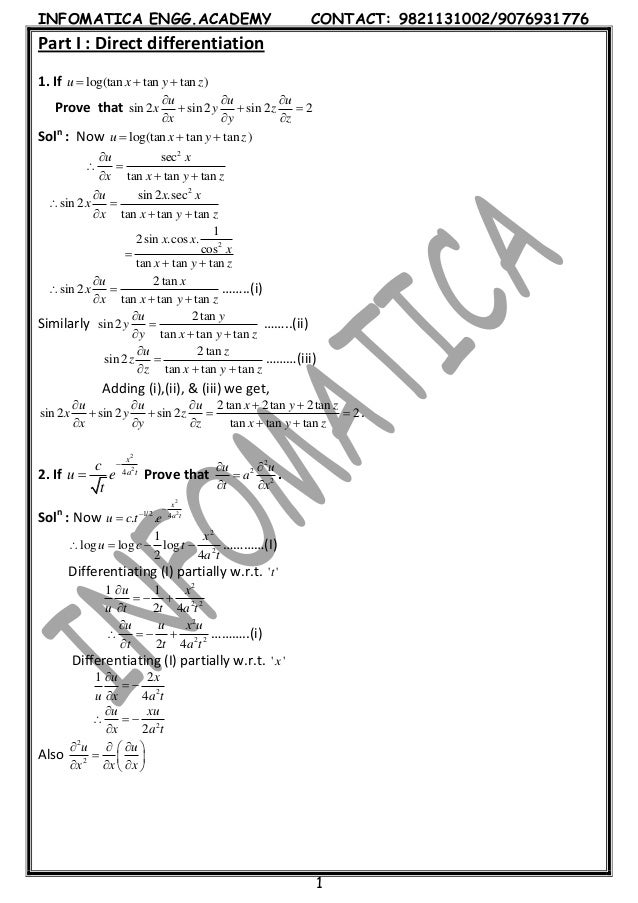



Partial Differentiation




If Y Tan 1 X 1 Sqrt 1 X 2 Then Find Dy Dx
(15) Find dy dx when y= 2x2 1 x p 1 x2 (16) Find dy dx when y= un (17) Find dy dx when y= p 1 x2 Derivatives with exponentials, logs and trig functions (1) Find dy dxIf` y = tan^1 x`, prove that ` (1 x ^2) (d^2y)/(dx^2) 2x (dy)/(dx) = 0` Maharashtra HSC exams 21 cancelled due to the COVID19 pandemic situationY=tan^1•√(x^21)csc^1•x, x>1 Thank You!' and find homework help for other Math questions at eNotes



1




21 Differentiation And Integration Of Trigonometry Function 9709
Answer to y = 1/2 ln 1 x/1 x y = 1/2 ln 1 x^2/1 x^2 y = ln (ln x) y = ln(ln 1/x) y = ln x/squareroot x^2 1 y = ln 4x^3/s Stack Exchange network consists of 177 Q&A communities including Stack Overflow, the largest, most trusted online community for developers to learn, share their knowledge, and build their careers Visit Stack ExchangeIf y=tan^ (−1) ( (√ (1x^2)√ (1−x^2))/ (√ (1x^2)−√ (1−x^2))) , x2≤1, then find dy/dx Mathematics If `y=tan^ (−1) ( (sqrt (1x^2)sqrt (1−x^2))/ (sqrt (1x^2)−sqrt (1−x^2)))` , x2≤1, then find dy/dx




Se13e01 01 Gif



What Is The Value Of Dy Dx If Y Tan 1 4 X 1 4x Quora
if y= tan1 ((1x 2) 1/2x) then find dy/dx Share with your friends Share 1 Let y = tan1 1 x 2Answer and Explanation 1 Become a Studycom member to unlock this answer! = x 1)f0(x) = 1(x 2) = 1 x2 Derivative of a constant times a function Theorem (Constant Multiple Rule) Let c be a real number and y = f(x) a function of x If f is di erentiable at x and y = cf(x) then dy dx = d dx (cf(x)) = c d dx f(x) Calculus I 3 c 1416 Brenda BurnsWilliams and Elizabeth Dempster Last update
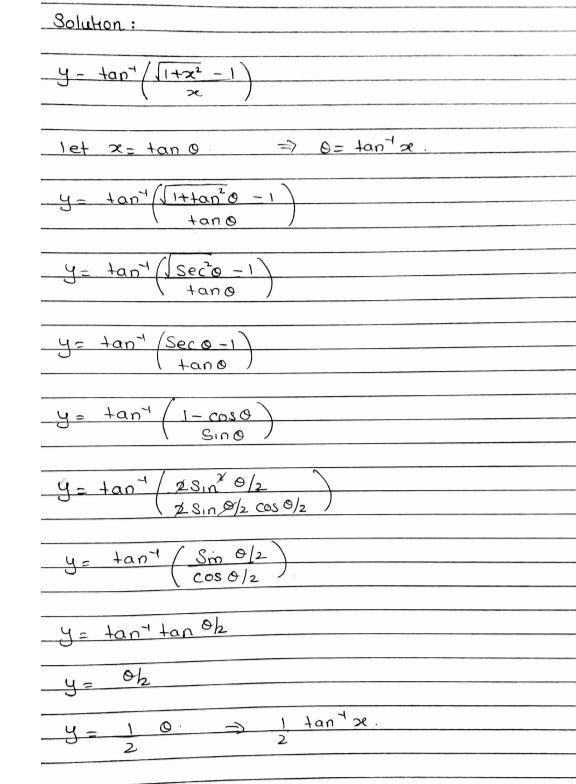



Find Frac Dy Dx If Y Tan 1 Left Frac Sqrt 1 X 2 1 X Right Where e 0 Snapsolve




If Y Tan 1 X Sqrt 1 X 2 1 Then Dy Dx Youtube
Math find implicit differentiation (12xy^3)^5=x4y Calculus Find dy/dx by implicit differentiation for x^2 2xy y^3 = C calculus3 If x = secθ − cos θ, y = secnθ − cosnθ , then (x2 4)(dy dx)2 is equal to VITEEE 10 4 Let f(x) = x x and g(x) = sinx Statement1 gof is differentiable at x = 0 and its derivative is continuous at that point Statement2 gof is twice differentiable at x = 0 AIEEE 09The derivative of y in terms of x is denoted by `(dy)/(dx)` or `y'` For the given problem `y = 1/2(1/2ln((x1)/(x1)) arctan(x))` , we may apply the basic differentiation property `d/(dx) c




Show That Z Ln X 2 Y 2 2 Tan 1 Y X Satisfies The Laplaces S Equation Mathematics Stack Exchange




Y Tan 1 Sqrt 1 X 2 Sqrt 1 X 2 Sqrt 1 X 2 Sqrt 1 X 2 W H E R E 1 Ltx Lt1 X 0 Youtube
Find dy/dx, y= tan^1 1x/1x tan ^1 x2/12x Share with your friends Share 4 y = tan1 1x 1 xtan1 x 2 12 x put x = tan Ex 53, 11 Find 𝑑𝑦/𝑑𝑥 in, 𝑦 = cos–1 ((1− 𝑥^2)/( 1 𝑥2 )) , 0 < x < 1 𝑦 = cos–1 ((1− 𝑥^2)/( 1 𝑥2 )) Putting x = tan θ y Given y = tan–1 (2x/ 1 x2) Put x = tan θ ⇒ θ = tan–1x y = tan–1 (2 tan θ/ 1 tan2 θ) = tan–1 (tan 2θ) = 2θ = 2tan–1x differentiating wrto 'x' on both sides, we have (dy/dx) = 2 (d/dx




Assignments For Class Xii
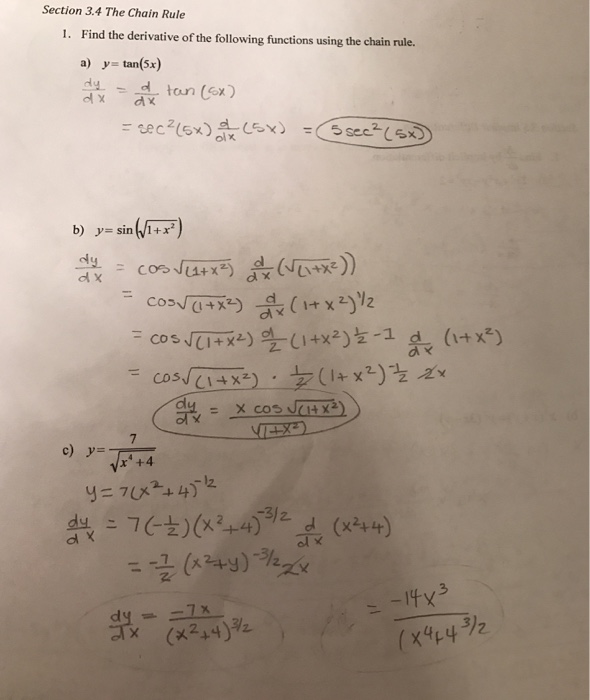



Find The Derivative Of The Following Functions Using Chegg Com
Y5 x2y3 = 1yex2 find dy/dx by implicit differentiation Answer Differentiating both sides with respect to x yields 5y4 dy dx 2xy3 x2(3y2) dy dx = dy dx ex2 y(2x)ex2 Rearranging so that all terms containing dy/dx are on the left side gives 5y4 3x2y2 −ex2 dy dx = 2xyex2 −2xy3 Thus, dy dx = 2xyex2 −2xy3 5 y4 3x 2 −ex2 2Now, y = sin1 x 2 1 x 2 Thus, range of the given function is 0, π 2) Answer Zigya App 16 If y = sec (tan1 x), then dy/dx at x = 1 is equal toPut x=tany,now tan^1 ( (1x)/ (1x))= tan^1 ( (1tany)/ (1tany))=tan^1 ( (tanπ/4tany)/ (1tanπ/4×tany))=tan^1 (tan (π/4y))=π/4y=π/4tan^1 (x) is our answer 942 views Sponsored by Angular Fitness The Rock admits this was the best decision he ever made The big companies don't want you to know his secrets




Ex 5 3 10 Find Dy Dx In Y Tan 1 3x X3 1 3x2 Ex 5 3
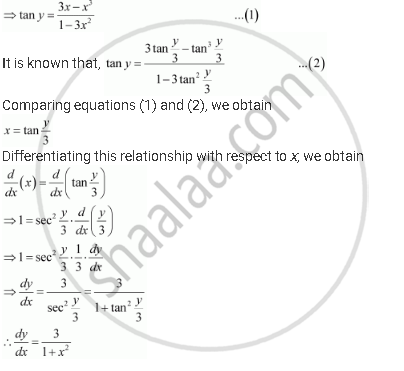



Find Dy Dx For Y Tan 1 3x X 3 1 3x 2 1 Sqrt3 X 1 Sqrt3 Mathematics Shaalaa Com
But if x is given y has many values We can express y interms of x as y = sin –1 x "Inverse sine of x" The Quantities sin –1 x, cos –1 x, tan –1 x, cot –1 x, sec –1 x, cosec –1 x are called Inverse Trigonometric Functions find dy dx y sin 1 x2 1 x2 Mathematics TopperLearningcom 8s1l799Solve your math problems using our free math solver with stepbystep solutions Our math solver supports basic math, prealgebra, algebra, trigonometry, calculus and more




Implicit Differentiation Advanced Example Video Khan Academy




Misc 44 Value Fo Tan 1 2x 1 1 X X2 Dx Is Miscellaneous
Homework Statement find dz/dy(partial) z= tan1(y/x) Homework Equations The Attempt at a Solution z= tan1(y/x) let u=y/x z= tan1(u) dz/du = 1/ (1u2) so dz/dy = dzThe derivative of the tan inverse function is written in mathematical form in differential calculus as follows ( 1) d d x ( tan − 1 ( x)) ( 2) d d x ( arctan ( x)) The differentiation of the inverse tan function with respect to x is equal to the reciprocal of the sum of one and x squared d d x ( tan − 1Create your account View this answer Recall that d dx (tan−1x) = 1 x21 d d x ( tan − 1 x) = 1 x 2 1 so we




If Y Tan 1 2 X1 2 2x 1 Then Dydx At X 0 Is




Question 10 Find Dy Dx Y Tan 3x X 1 3x 1 3 Lt X Lt 3 Class 12 Math Continuity Brainly In
If y = tan1 a/x log (xa/xa) 1/2, prove that dy/dx = 2a 3 /(x 4 – a 4) Mention each and every step Queries asked on Sunday & after 7pm from Monday to Saturday will be answered after 12pm the next working dayClick here👆to get an answer to your question ️ If y = tan^1 ( √(1 x^2)√(1 x^2)√(1 x^2)√(1 x^2) );Dy/dx Please I need help and thank you very much!




Y Tan 1 A X Log X A X A Prove That Dy Dx 2a 3 X 4 A 4 Brainly In



Www Wyzant Com Resources Answers How Do You Prove That The Derivative Of Inverse Tangent Is 1x2 1
Get an answer for 'Find the derivative of y with respect to the appropriate variable?? dy dx = sec2(x − y) 2xy (1x2)2 sec2(x − y) 1 1x2 Note now that sec2(x − y) = 1 tan2(x − y) = 1 y2 (1 x2)2 so dy dx = 1 y2 (1x2)2 2xy (1x2)2 1 y2 (1x2)2 1 1x2 and multiplying numerator and denominator by (1 x2)2 dy dx = (1 x2)2 y2 2xy (1 x2)2 y2 1 x2 dy dx = x4 2x2 y2 2xy 1 x4 3x2 y2 2 UP Primary and Upper Primary Schools to Reopen from 01 July UP state government has ordered that 15 lakh government primary and upper primary schools across the state will reopen from 01st July 21 CBSE Class 12 evaluation Criteria Class 10, 11 & 12 marks in ratio CBSE class 12 evaluation criteria is out




If Y Tan 1 Sinx 1 Cosx Prove That Dy Dx 1 2 Youtube




Y Tan 1 Sinx 1 Cosx Find Dy Dx
Get answer Find the (dy),(dx) of y=tan^(1)((sqrt(x)x),(1x^(3,,2))) Apne doubts clear karein ab Whatsapp par bhi Try it nowLet ` y=tan^1 ( (6x)/ (15x^2))` `=tan^1 ( (x5x)/ (15x^2))` `y=tan^1 (x)tan^1 (5x)` Differentiating wrt x `dy/dx=1/ (1x^2)1/ (125x^2)xx5` `=1/ (1x^2)5/ (125x^2)`If Y Tan 1 X Sqrt 1 X 2 1 Then Dy Dx Youtube For more information and source, see on this link Solved If Y Tan 1 X 2 3x Then Dy Dx 1 1 X 2 Chegg Com For more information and source, Ex 5 3 10 Find Dy Dx In Y Tan 1 3x X3 1 3x2 Ex 5 3 For more information and source, see on this link




Solved Find Dy Dx If 2x 3y 2 4y 6x 2 Find The Deri Chegg Com



Find The General Solution Of The Differential Equation 1 Y2 X Etan 1y Dy Dx 0 Studyrankersonline
Answer d y d x = − 1 2 x x 2 − 1 My 1st attempt I followed the simple method and started by taking darivative of tan inverse and the following with chain rule and i got my answer as ( − 1 2 x x 2 − 1 ), which is not same as the above correct answer 2nd method is that you can substitute x = sec If y = logtan(π 4 x 2), then dy dx = 6 If y = sin2(tan − 1√1 − x2 1 x2), then dy dx = 7 If √x y √y x = √a , then dy dx = 8 If x = 1 − t 1 t;



Prove That Tan 1 1 X2 1 X2 1 X2 1 X2 P 4 1 2 Cos 1x2 Studyrankersonline




Rd Sharma Class 12 Maths Solutions Chapter 11 Differentiation




Ex 5 3 9 Find Dy Dx In Y Sin 1 2x 1 2x2 Chapter 5



If Log Y Tan 1 X Then Show That 1 X 2 D 2y Dx 2 2x 1 Dy Dx 0 Sarthaks Econnect Largest Online Education Community
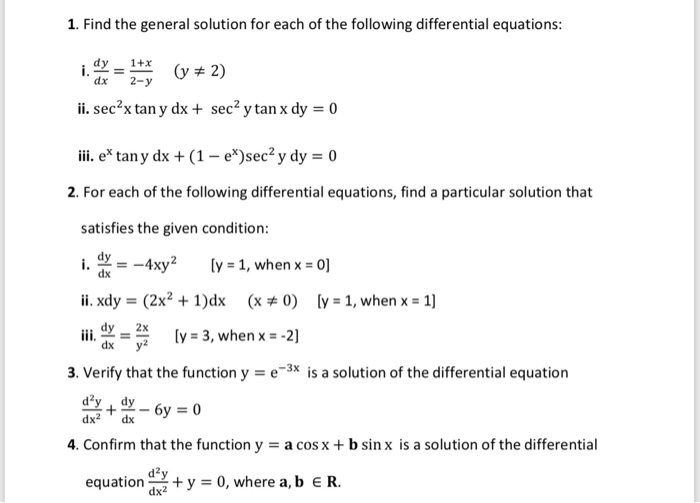



1 Find The General Solution For Each Of The Chegg Com



How To Differentiate Y Tan 1 2x 1 X 2 For The Inverse Trigonometric Function Quora




W H A T I S D 2 Y D X 2 Zonealarm Results
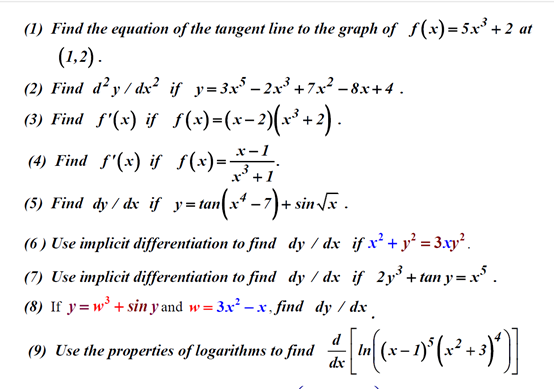



Solved X 1 1 Find The Equation Of The Tangent Line To T Chegg Com




Lesson 40 Derivatives Of Secondary Trig Functions Inverse



1
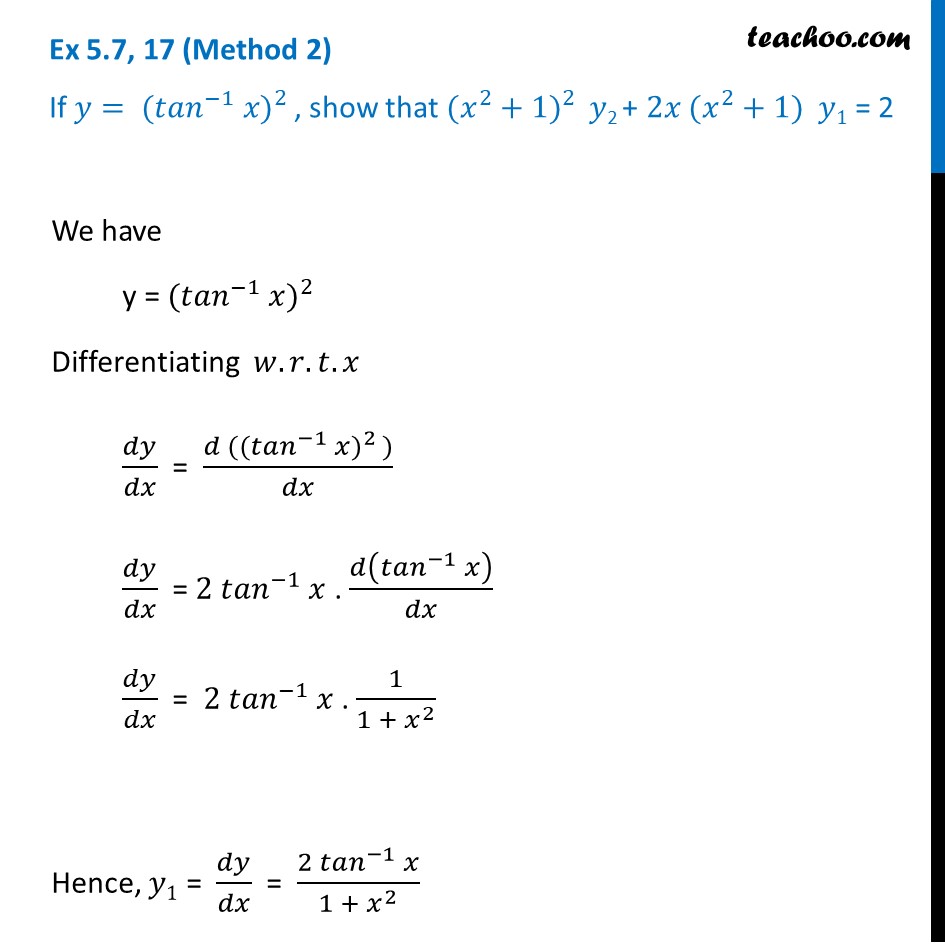



Ex 5 7 17 If Y Tan 1 X 2 Show X2 1 Y2 2x X2 1




If Y Ex Tan 1 X Prove That 1 X2 D2y Dx2 2 1 X X2 Dy Dx 1 X 2 Y 0 Maths Continuity And Differentiability Meritnation Com




I 1 Y Tan 1 X F I N D D 2y Dx 2 2 D Y 11 If Y Tan 1x Find 2 Dx Youtube
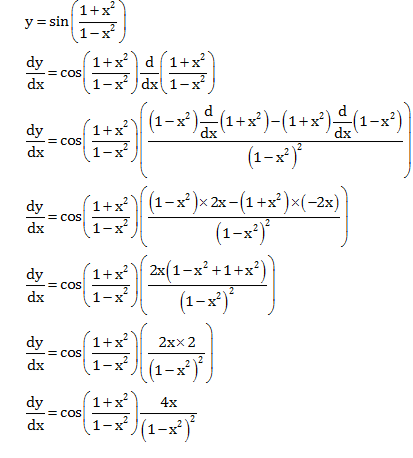



Find Dy Dx Y Sin 1 X2 1 X2 Mathematics Topperlearning Com 8s1l799




If Y Tan 1 1 1 X X 2 Tan 1 1 X 2 3x 3 Tan 1 1 X 2 5x 7 Upto N Terms Then Fin Youtube




Math 113 Hw 7 Solutions Pdf Free Download



If Y Tan 1 1 X 2 1 X 2 1 X 2 1 X 2 Find Dy Dx Sarthaks Econnect Largest Online Education Community




Example 27 Find Derivative Of F X Tan 1 X Class 12




Ex 5 3 12 Find Dy Dx In Y Sin 1 1 X2 1 X2 Chapter 5




Find Dy Dx In The Following Y Tan 1 3x X 3 1 3x 2




If Y Tan 1 1 Cosx1 Cosx Then Dydx



If Y E Tan 1x Show That X 2 1 D 2y Dx 2 2x 1 Dy Dx 0 Sarthaks Econnect Largest Online Education Community




If Y Tan 1 1 X 2 1 X 2 1 X 2 1 X 2 X 2 1 Then Find Dy Dx




If Y Tan 1 X 1 3 A 1 3 1 X 1 3 A 1 3 Then Find Dy Dx Youtube




Find Dy Dx If Y Tan 1 A X 1 Ax Wyzant Ask An Expert




If Y Tan 1 X 1 Sqrt 1 X 2 Then Find Dy Dx



What Is The Value Of Dy Dx If Y Tan 1 4 X 1 4x Quora



Q Tbn And9gcssp2 7fyz3j2ny005jbktvc79izmavixzm H7ylgukjb6hwogm Usqp Cau




Worked Example Implicit Differentiation Video Khan Academy



Solve The Following Differential Equation 1 X 2 Dy Dx Y Tan 1x Sarthaks Econnect Largest Online Education Community



Find Dy Dx If Y Xtanx X2 1 2 Studyrankersonline




If Y Tan 1 1 X 2 1 X 2 Then Dy Dx
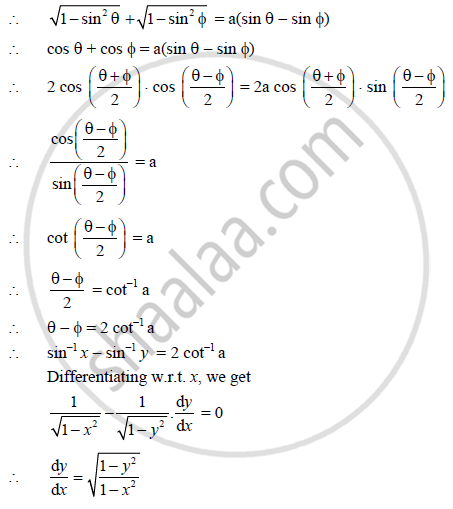



If Sqrt 1 X 2 Sqrt 1 Y 2 A X Y Show That Dy Dx Sqrt 1 Y 2 1 X 2 Mathematics And Statistics Shaalaa Com




If Y Tan 1 2x 1 X 2 Then Prove That Dy Dx 2 1 X 2




If Y Tan 1 X 2 Prove That 1 X2 2y2 2x 1 X2 Y1 2 Explain In Great Detail Mathematics Topperlearning Com Z68xug




Ex 2 2 5 Simplify Tan 1 Root 1 X2 1 X Chapter 2



Solve The Differential Equation 1 X 2 Dy Dx Y E Tan 1 X Sarthaks Econnect Largest Online Education Community




If Tan 1 X2 Y2 X2 Y2 A Prove That Dy Dx X 1 Tana Y 1 Tana Brainly In




Q33 If Y Tan 1 1 X 2 1 X 2 1 X 2 1 X 2 Find Dy Dx Youtube




Differentiate Tan 1 1 X2 1 2 1 X Wrt Sin 1 2x 1 X2 Explain In Great Detail Mathematics Topperlearning Com Yx862gdd



Solve The Following Differential Equation 1 X 2 Dy Dx Y Tan 1x Sarthaks Econnect Largest Online Education Community




If Y Tan 1 Sqrt 1 X 2 Sqrt 1 X 2 Sqrt 1 X 2 Sqrt 1 X 2




If U Sin 1 X 2 Y 2 X Y Then Show That X Du Dx Y Du Dy Tan U Mathematics 1 Question Answer Collection
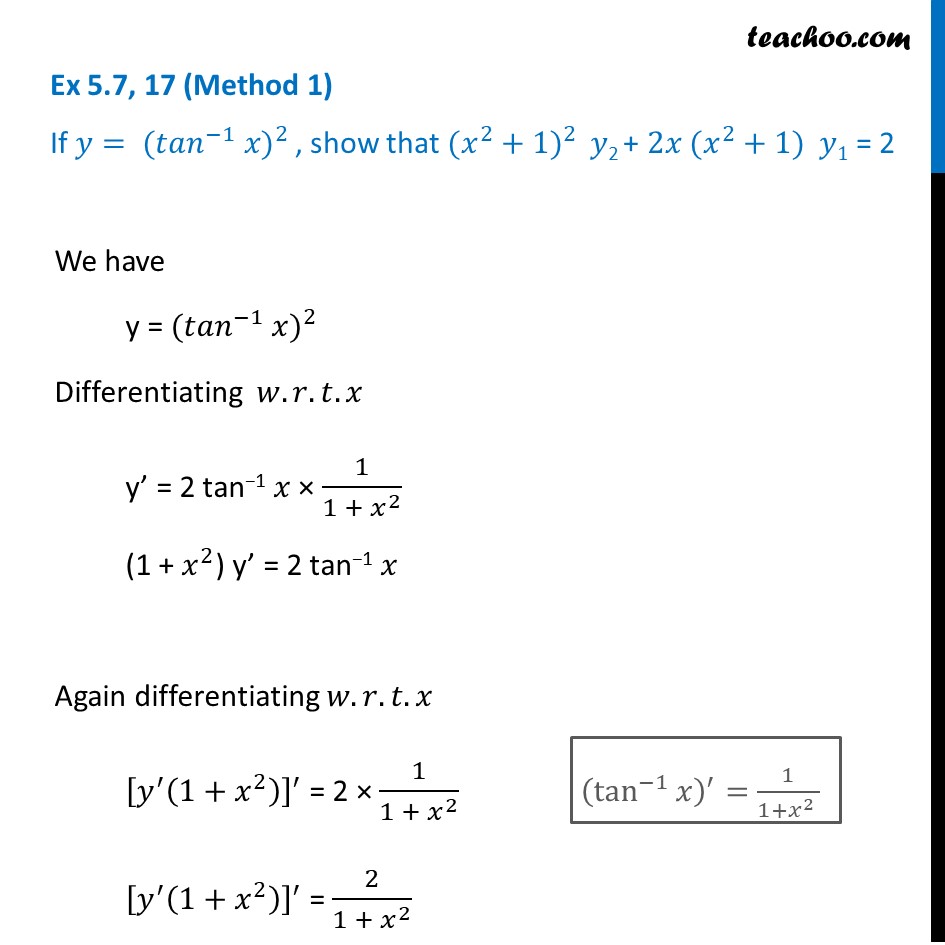



Ex 5 7 17 If Y Tan 1 X 2 Show X2 1 Y2 2x X2 1
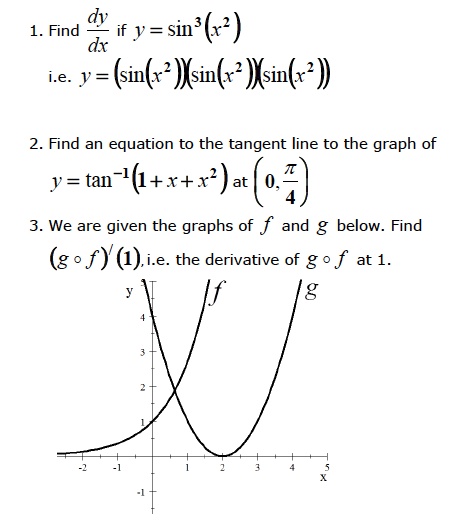



Find Dy Dx If Y Sin 3 X 2 I E Y Chegg Com



Q Tbn And9gctc4r8yccwydnkxzfs2px C6xltwhwlsp6osqtofvetqes2prvg Usqp Cau




If Y Tan 1 2 X 1 2 2x 1 T H E N Dy Dx A Tx 0 Is 1 B 2 C 1n 2 D None Of T Youtube




If Y Tan 1 Sinx Cosx Cosx Sinx Then Find Dy Dx Brainly In
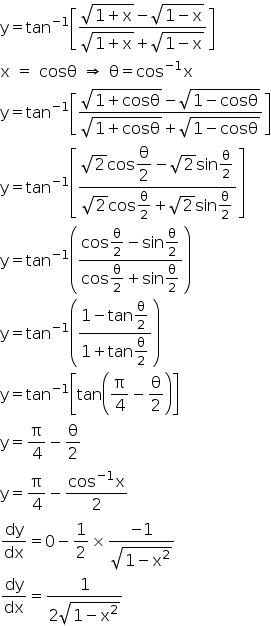



If Y Tan 1 1 X 1 2 1 X 1 2 1 X 1 2 1 X 1 2 Prove That Dy Dx 1 2 1 X2 1 2 Mathematics Topperlearning Com Fuf1cdaa




If Y Tan 1 A X Log X A X A 1 2 Prove That Dy Dx 2a3 X4 Mention Each And Every Step Mathematics Topperlearning Com Yo8siu77




If Y Tan 1 Sec X Tan X Then Dy Dx Is Equal To Youtube




If Log Y Tan 1x Show That 1 X2 Y2 2x 1 Y1 0 Maths Continuity And Differentiability Meritnation Com




Ipe Material Notes



How To Differentiate Y Tan 1 2x 1 X 2 For The Inverse Trigonometric Function Quora
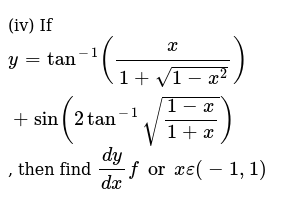



Iv If Y Tan 1 X 1 Sqrt 1 X 2 Sin 2tan 1 Sqrt 1 X




If Y Ex Tan 1 X Prove That 1 X2 D2y Dx2 2 1 X X2 Dy Dx 1 X 2 Y 0 Maths Continuity And Differentiability Meritnation Com




If Y Sin 2tan 1 1 X 1 X 1 2 Then Find Dy Dx And If 5 X 5 Y 5 X Y Then Prove That Dy Dx 5 Y X 0 Mathematics Topperlearning Com Q011rcnn




Find Dy Dx If Y Tan Inverse Square Root Of 1 X 2 Square Root Of 1 X 2 Square Root Of Maths Continuity And Differentiability Meritnation Com
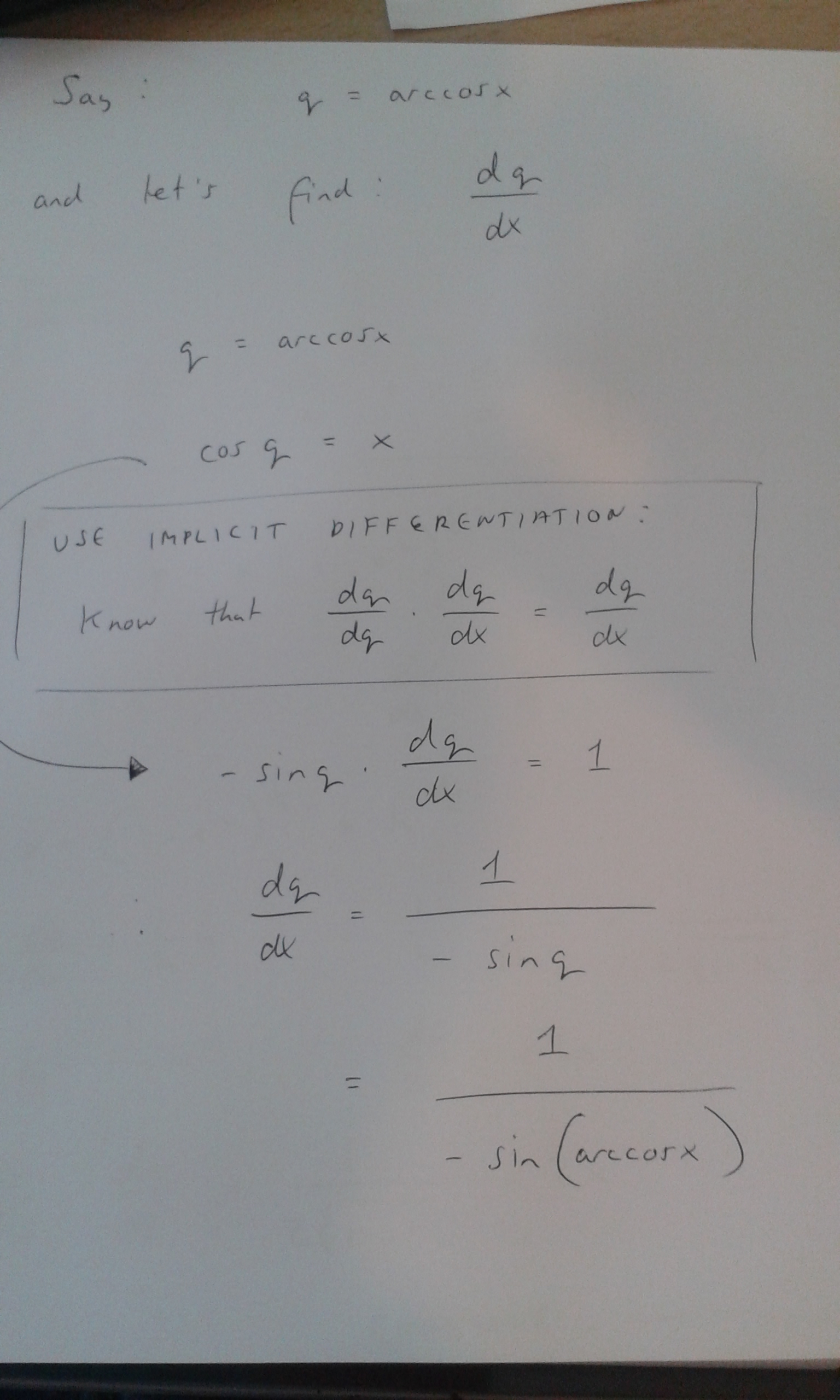



How Do You Differentiate Y Arccosx X Sqrt 1 X 2 Socratic
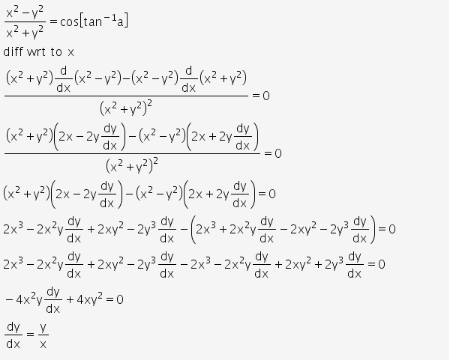



If Cos 1 X2 Y2 X2 Y2 Tan 1 A Prove That Dy Dx Y X Cbse Class 12 Learn Cbse Forum



Solve The Differential Equation 1 Y2 Tan 1 X Dx 2y 1 X2 Dy 0 Studyrankersonline
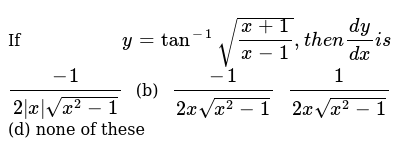



If Y Tan 1 Sqrt X 1 X 1 T H E N Dy Dx I S 1 2 X S



If Y Tan 1 2 X 1 2 2x 1 Then Dy Dx At X 0 Is Sarthaks Econnect Largest Online Education Community



Differentiation Of Math Y Tan 1 Dfrac Sqrt 1 X Sqrt 1 X Sqrt 1 X Sqrt 1 X Math How Can I Solve This Quora




Ex 5 3 10 Find Dy Dx In Y Tan 1 3x X3 1 3x2 Ex 5 3




Differentiate The Following W R T X Tan 1 X 1 6x 2 Cot 1 1 10x 2 7x




If Y Tan 1 Sqrt 1 Cosx 1 Cosx Prove That Dy Dx 1 2 Youtube
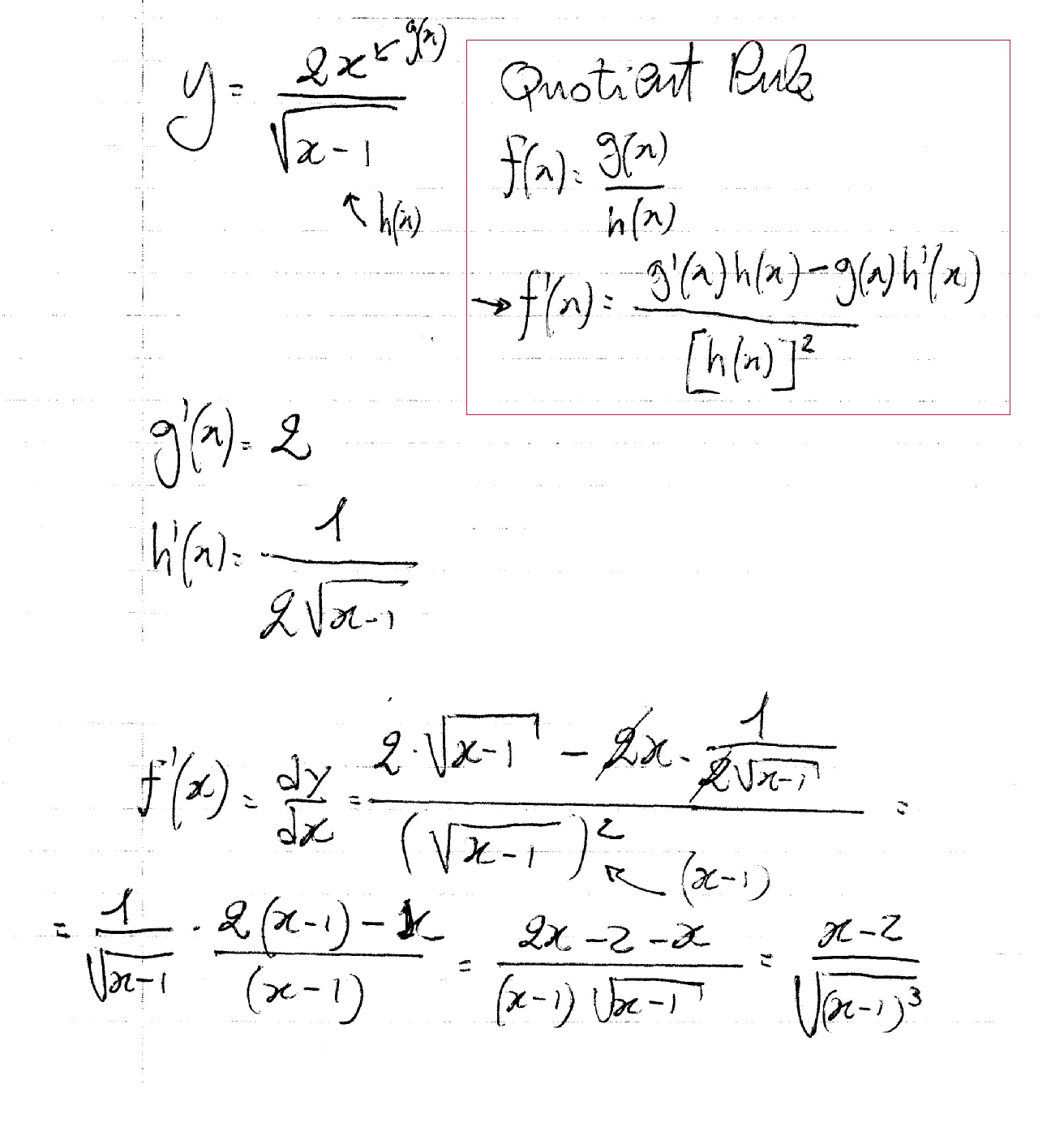



How Do You Find Dy Dx For Y 2x Sqrt X 1 Socratic




If Y Tan 1 Ax B Bx A Prove That Dy Dx 1 1 X 2




If Y Tan Inverse Root 1 X Root 1 X Root 1 X Root 1 X Find Dy Dx Maths Inverse Trigonometric Functions Meritnation Com



If Y Tan 1 1 Sin X 1 Sin X 1 Sin X 1 Sin X Where P X 3p 2 Find Dy Dx Sarthaks Econnect Largest Online Education Community
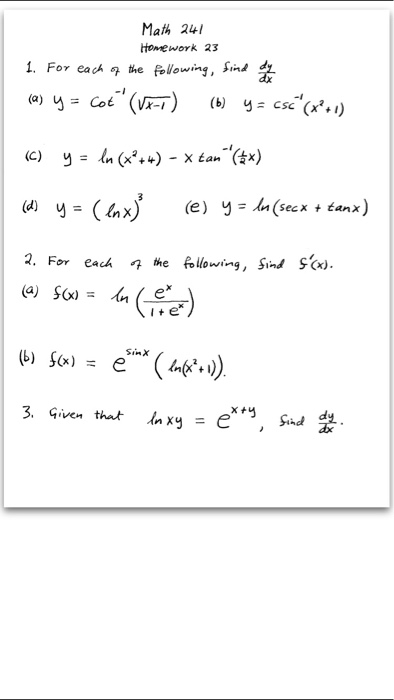



For Each Of The Following Find Dy Dx A Y Cot 1 Chegg Com




Ex 5 3 13 Find Dy Dx In Y Cos 1 2x 1 X2 Ncert Ex 5 3
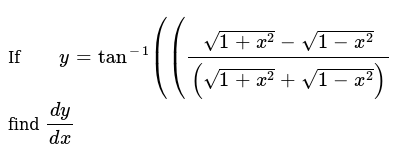



If Y Tan 1 Sqrt 1 X 2 Sqrt 1 X 2 Sqrt 1 X 2 Sqrt 1 X 2




If Y Tan 1x 2 Show That X 2 1 2y2 2x X 2 1 2



Dy Dx Y Tan 1 3x X 3 1 3x 2 1 3 X 1 3 Sarthaks Econnect Largest Online Education Community



0 件のコメント:
コメントを投稿